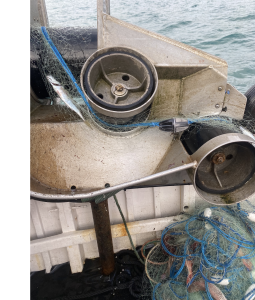Through Clean Catch, we’re developing a device that has big potential to reduce bycatch of porpoises and dolphins in gillnets with minimal fuss for fishermen. Read on to find out more about how it’s designed to work and our progress so far.
Led by consortium partner Arribada Initiative, Clean Catch has been developing something called a ‘Passive Acoustic Reflector’ (PAR) over the last few years. PARs are built with materials that can reflect sounds such as the echolocations made by dolphins and porpoises, warning them of the presence of a net they might otherwise become entangled in. The approach is similar to that of Acoustic Deterrent Devices, aka pingers, but key differences are that PARs don’t produce their own sound and therefore don’t need batteries.

A PAR passes successfully through a hydraulic hauler (Source: Arribada Initiative)
Putting the PARs through their paces
As well as being practical in the sense that PARs don’t need to be charged or have batteries added, Clean Catch’s PAR is designed to replace the floats already used on gillnets.
That’s the idea, of course – but we need to be sure that the PARs will stand up to the rigours that fishing gear is put through on a daily basis out at sea. That’s why between August 2024 and January 2025, we carried out a robustness trial with a small-scale Cornish gillnetter to put 19 of the PARs through their paces. The result? The devices withstood the mechanical demands of active fishing with minimal failure. In the cases where individual devices failed, we were able to identify how an improved manufacturing process could avoid the issue in future.
Where do we go next with testing?
While we’d initially planned to run a trial using dummy nets to work out whether toothed whales such as harbour porpoises show behavioural responses to the PARs. However, with input from members of Clean Catch’s National Advisory Board and other subject matter experts, scoping work identified limitations with this plan.
In response, we have formed an Expert Working Group (EWG) to help steer the future direction, with four alternatives now being explored:
- Behavioural studies using hydrophones.
- International trials with fisheries experiencing high bycatch rates (e.g. Peru).
- Acoustic tank testing to optimise PAR design and placement on nets.
- Collaborative workshops with fishermen to improve real-world rigging.
A collaborative route forward
The process of creating and developing the PARs illustrates how science, innovation, and co-design with fishermen can come together to address bycatch. With further refinement and testing, PARs could offer a scalable, low-impact solution to help reduce bycatch.
Here’s what one of the fishermen we’ve been collaborating with had to say about the PAR development process:
“Working with the team at Arribada has been very rewarding. Supporting the development and testing of Passive Acoustic Reflectors at sea on commercial fishing gear has been an interesting challenge. I look forward to continuing this work to support the wider fishing industry in helping to develop a device that is both compatible with modern fishing gear and a viable solution to bycatch.”
Read the latest progress report on our PARs work now.